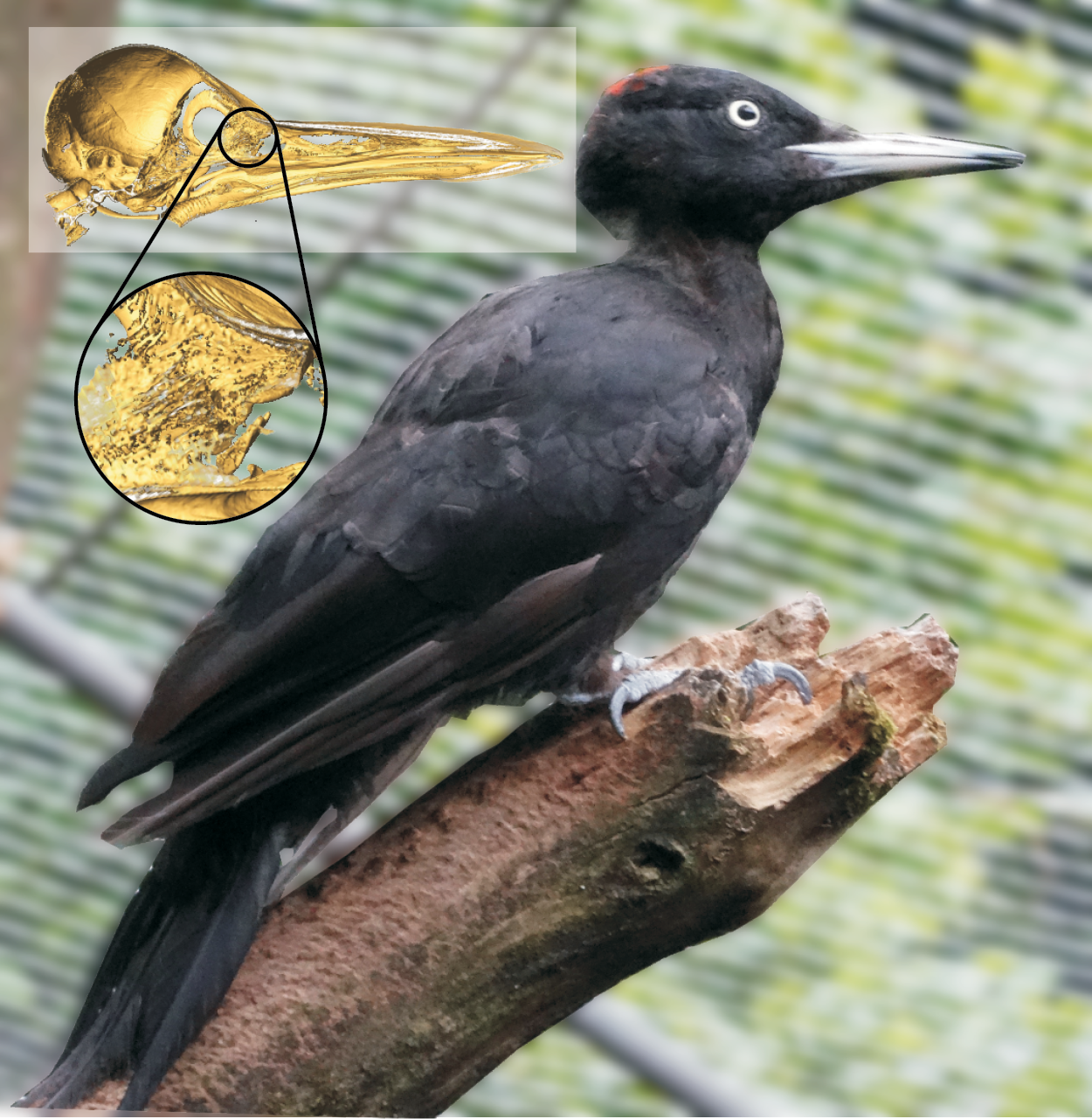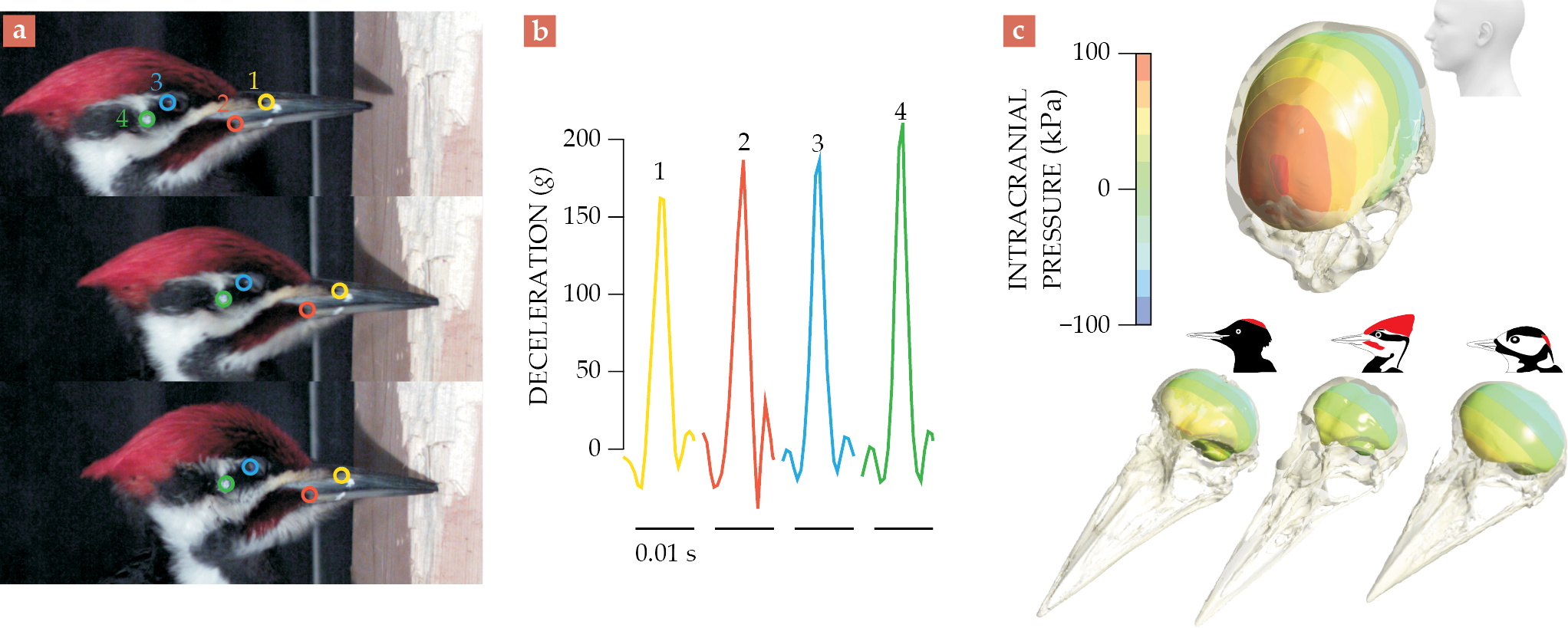Why woodpeckers don’t get concussions
DOI: 10.1063/PT.3.5385
When knocking away pieces of hard woody bark to find food, digging nesting holes into tree stems, or making drumming sounds to lure mates or announce their territories, woodpeckers generally strike trees with their beaks at speeds of 20 kilometers per hour and can reach rates up to 30 times per second during drumming. So a sudden deceleration would exceed the threshold that would render a concussive blow—at least to a human brain. But to judge from many popular accounts, internet blogs, information panels in zoos, and educational television programs, the birds’ brains emerge unharmed thanks to shock-absorption structures in the skull.
Bird enthusiasts may be comforted by the idea that a shock wave traveling backward from the impacting beak becomes cushioned before it reaches the brain. And the idea gained strength in the past decade when computed tomography reconstructions revealed a zone of spongy bone at the front of a woodpecker’s brain, as shown in figure
Figure 1.

A black woodpecker and an x-ray computed tomography reconstruction of the left half of the skull. The enlarged circle shows the spongy bone, located at the interface between the beak and the cranium, that had been hypothesized to serve as a shock absorber.

That porous zone consists of interconnected bony rods and plates, which could theoretically be compressed on impact to reduce the shock to the brain. But although it inspired the design of new shock-absorbing materials and helmets, the hypothesis had not been tested. What’s more, several scientists strongly doubted it even earlier. In the 1970s psychiatrist Philip May and coworkers saw the potential of learning from anatomical adaptations in woodpeckers to withstand repeated blows. Yet in their 1976 Lancet article, they questioned whether the cranial absorption of shocks was part of those adaptations. “If the beak absorbed much of its own impact, the unfortunate bird would have to pound even harder,” the authors wrote.
It would be maladaptive for a bird to first build up sufficient kinetic energy to deliver a strong hit to a tree by accelerating its head forward, only to lose part of that energy into its own built-in skull–beak shock absorber. (With ophthalmologist Ivan Schwab, May was posthumously awarded the 2006 Ig Nobel Prize in Ornithology for his work.)
Video evidence
As part of an international research team two years ago, we looked at three species of woodpeckers to see whether shock absorption was really taking place between the beak and the brain. We recorded high-speed videos of the birds during pecking. In Europe, those videos were made in four zoo aviaries with a black woodpecker (Dryocopus martius) and great spotted woodpecker (Dendrocopos major). In Canada, recordings were made of two pileated woodpeckers (Dryocopus pileatus) kept in the laboratory. Akin to how video is used in automobile crash tests, we used consecutive video frames to track the movement of landmarks on the birds’ heads and then calculated their peak deceleration with impact.
The landmarks for all of them were two spots on the beak and one on the eye, which we assumed moves along with the front of the braincase. The pileated woodpecker had an additional landmark, a small white dot painted on the skin covering the braincase, as shown in figure
Figure 2.

Impact analysis. The four tracked landmarks (a) on the beak and near the braincase of a pileated woodpecker. (b) This representative example shows the deceleration of those landmarks. (c) The results of a brain-cavity pressure simulation show that even the strongest decelerations analyzed in three species of woodpecker—(left to right) black, pileated, and great spotted—yield pressures that are lower than those in a human brain with the mildest concussion.

We consistently found no reduced deceleration of the braincase compared with that of the beak, as seen in the results in figure
Avoiding injury
But without shock absorption in the skull, how do woodpeckers protect their brains from injury? Our data show that woodpecker brains are subjected to decelerations of up to 400 g, where g is the acceleration due to gravity. That far exceeds the estimated threshold of 135 g to cause concussions in humans. As pointed out in 2006 by MIT’s Lorna Gibson, the answer lies in the mass difference between the brains of woodpeckers and those of humans. She found that the keys to the birds’ ability to withstand high decelerations include their small size, which reduces stress on the brain for a given deceleration; the short duration of the impact, which increases their toleration of it; and the orientation of the brain in the skull. The pressure in the woodpecker’s brain under its own deceleration is proportional to the product of the bird’s deceleration, the mass density of its brain tissue, and the brain length, or volume/area.
The relevant length is that of the brain in the direction of impact. The brain of a woodpecker has roughly one seventh the length of a human’s. And thus the woodpecker’s deceleration threshold for concussions equivalent to the human’s threshold would be 7 × 135 g, or about 1000 g. The upshot is that even the hardest hits from our data set—roughly 400 g—are not as violent as they appear. The birds maintain a considerable margin of safety and still suffer no brain injury, even if they were to accidentally hit a material stiffer than wood; for a comparison between human- and woodpecker-brain pressures in response to the strongest decelerations, see figure
Shock absorption in woodpeckers is a good example of how hypotheses can spread to become common beliefs even with no scientific evidence supporting them. The combination of spectacular behavior receiving plenty of popular-media coverage and humans focusing on brain-protection adaptations when it comes to head impacts can be misguiding. The two factors may be responsible for the mythologizing of how woodpeckers avoid injury. We hope that our biomechanical evidence can help change that belief.
We would like to thank our collaborators Erica Ortlieb, Christine Böhmer, Robert Shadwick, and Anick Abourachid.
References
► S. Van Wassenbergh et al., “Woodpeckers minimize cranial absorption of shocks,” Curr. Biol. 32, 3189 (2022). https://doi.org/10.1016/j.cub.2022.05.052
► A. A. Biewener, “Physiology: Woodpecker skulls are not shock absorbers,” Curr. Biol. 32, R767 (2022). https://doi.org/10.1016/j.cub.2022.06.037
► L. J. Gibson, “Woodpecker pecking: How woodpeckers avoid brain injury,” J. Zool. 270, 462 (2006). https://doi.org/10.1111/j.1469-7998.2006.00166.x
► E. R. Schuppe et al., “Evolutionary and biomechanical basis of drumming behavior in woodpeckers,” Front. Ecol. Evol. 9, 649146 (2021). https://doi.org/10.3389/fevo.2021.649146
More about the Authors
Sam Van Wassenbergh is a professor of animal mechanics and Maja Mielke is a doctoral candidate in the functional morphology laboratory at the University of Antwerp in Belgium.


